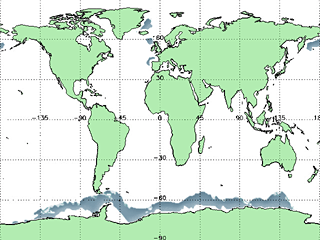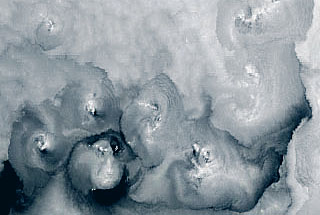
"Convective Cells"
"Cloud Curls" Structure (CUS)
Cloud Structures tentatively called Cloud Curls occur rather
seldom and mainly above circumpolar waters, most often above the waters
situated close to the Antarctic.
Cloud Curls emerge within cloud fields from Stratus and/or Stratocumulus
clouds. They usually appear in groups. The size of each curl varies from
40 to 80 km, rarely from 20-30 km to 120-140 km.
Quite often the Cloud Curls top is a little bit lower than the surrounding
cloud field top, and the curls themselves have an outer border which is
well marked and clearly seen.
An interesting peculiarity of this structure is that the top of the curls'
center is often lower than the top of their bulk (forming some kind of
a funnel-like relief) and has a greater albedo.
The types of cloudiness within cloud curls (according to the values resulted
from the processed MERIS level 2 data) are usually Stratocumulus (on the
rims) and Stratus (toward the centre of the structure).
The nature of the rise of such a structure is not clear.
It is possible to assume that the discrepancy in the temperature of the
sea surface beneath the cloud cover may stipulate for the initiation of
local winds. These winds interacting with the prevailing mesoscale wind
and experiencing the Coriolis effect (the cloud curls twist in one and
the same direction depending on the hemisphere, and there are no swirls
less than 15-20 km in size), which becomes stronger as the cloud approaches
the Poles, may form swirls.
The cold air is drawn out from upper atmosphere layers into these swirls,
cooling them.
As the result the swirls go down compared with the surrounding cloud field.
Cold heavy air that amasses in the center of the funnel cools the remaining
clouds, besides the reduction of pressure leads to the rise of the ice-point,
so that ice crystals appear (which is accompanied by the increase of their
albedo), and pushes them more downward.
|

